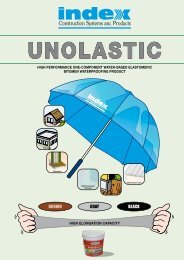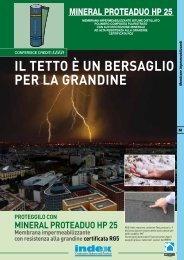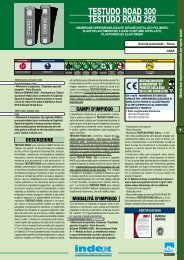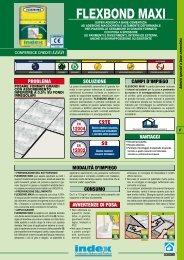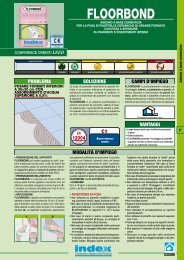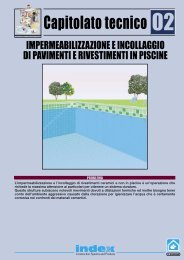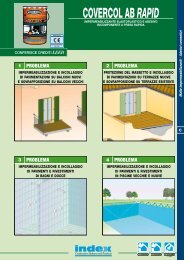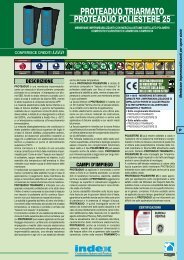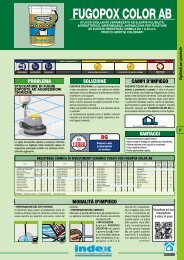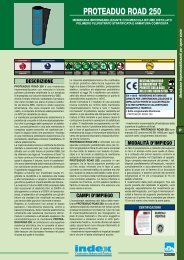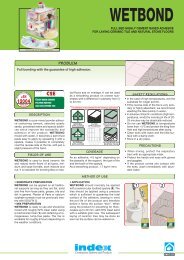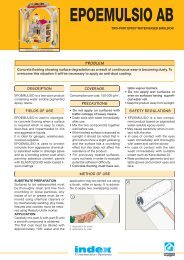Technical specification - Index S.p.A.
Technical specification - Index S.p.A.
Technical specification - Index S.p.A.
You also want an ePaper? Increase the reach of your titles
YUMPU automatically turns print PDFs into web optimized ePapers that Google loves.
VAPOUR BARRIER<br />
VAPOUR BARRIER WITH INCORPORATED HOT-MELT<br />
ADHESIVE FOR THE ADHESION OF THE LAYER OF<br />
THERMAL INSULATION AND HEAT BONDING OF EXPANDED<br />
POLYSTYRENE OR POLYURETHANE, THERMOBASE PSE,<br />
THERMOBASE PSE/EX AND THERMOBASE PUR PANELS<br />
4b. Expanded polystyrene<br />
or polyurethane thermal<br />
insulation panels<br />
4a. THERMOBASE PSE or<br />
THERMOBASE PSE/EX or<br />
THERMOBASE PUR<br />
thermal insulation<br />
VAPOUR BARRIER WITH INCORPORATED HOT-MELT<br />
ADHESIVE FOR THE ADHESION OF THE LAYER OF<br />
THERMAL INSULATION AND HEAT-BONDING OF<br />
HEAT-RESISTANT INSULATING PANELS OR<br />
THERMOBASE PUR PANELS<br />
4b. Heat-resistant thermal<br />
insulation panels<br />
4a. Isolante termico<br />
THERMOBASE PUR<br />
1. Support<br />
STRATIFIED<br />
ELEMENTS<br />
1. Support<br />
2. INDEVER or<br />
ECOVER primer<br />
3. TECTENE BV STRIP<br />
vapour barrier<br />
4a. THERMOBASE PSE<br />
or THERMOBASE PSE/<br />
EX or THERMOBASE<br />
PUR Thermal insulation<br />
4b. Expanded<br />
polystyrene or<br />
polyurethane thermal<br />
insulation panels<br />
1. Support<br />
STRATIFIED<br />
ELEMENTS<br />
1. Support<br />
2. INDEVER or<br />
ECOVER primer<br />
3. PROMINENT vapour<br />
barrier<br />
4a. THERMOBASE PUR<br />
thermal insulation<br />
4b. Heat-resistant<br />
thermal insulation<br />
panels<br />
2. INDEVER<br />
or ECOVER<br />
primer<br />
3. TECTENE BV STRIP ALU POLYESTER<br />
or TECTENE BV STRIP EP/V<br />
vapour barrier<br />
2. INDEVER<br />
or ECOVER<br />
primer<br />
3. PROMINENT ALU POLYESTER or<br />
PROMINENT POLYESTER or PROMINENT/V<br />
vapour barrier<br />
MEMBRANES:<br />
case E<br />
• TECTENE BV STRIP ALU POLYESTER<br />
case F<br />
• TECTENE BV STRIP EP/V<br />
Reinforced elastoplastomeric polymer-bitumen vapour barrier membranes,<br />
with the upper face covered in hot-melt strips for heat-bonding<br />
to the insulating panels, resistant and impermeable to gases and water<br />
vapour, to be chosen according to the vapour permeability (lower for the<br />
ALU POLYESTER version).<br />
These are products to be heat-bonded, which meet the <strong>specification</strong>s of<br />
sustainable building as by eliminating the melting pot for the oxidised bitumen,<br />
the risks of burns are notably reduced, the laying operations on the<br />
roof are reduced and therefore also the emission of fumes, smells and<br />
noise.<br />
• Application method on concrete laying surface<br />
Primer. The entire surface to be coated and the vertical parts onto which<br />
the waterproof covering must be bonded, are painted with a coat of about<br />
300 g/m 2 of INDEVER adhesion bituminous primer, or alternatively ECOV-<br />
ER water-based primer.<br />
Vapour barrier. The vapour barrier sheets are overlapped longitudinally<br />
by about 6 cm along the selvages with reduced thickness, especially provided<br />
on the edge of the sheet in order to allow overlapping without any<br />
protruding parts and to obtain a sufficiently flat laying surface for the insulating<br />
panels. The end overlap should be about 10 cm.<br />
The sheets of TECTENE BV STRIP EP/V are stuck to the laying surface<br />
with complete adhesion using a propane gas torch whereas TECTENE BV<br />
STRIP EP ALU POLYESTER is spot-bonded using the same technique.<br />
The bonding of the overlaps of both types is also performed using a torch.<br />
The continuity of the vapour barrier on the vertical parts is carried out<br />
by heat bonding, onto the edge of the bottom of the projecting parts, a<br />
band of elastoplastomeric polymer-bitumen membrane reinforced with<br />
composite non-woven polyester fabric coupled to aluminium foil, such as<br />
DEFEND ALU POLYESTER, in the event of laying STRIP EP ALU POLY-<br />
ESTER, or reinforced with a fibreglass felt such as DEFEND/V, in the event<br />
of laying STRIP EP/V, wide enough to cover the flat part by at least 10 cm<br />
and be turned up vertically by 5 cm more than the thickness of the envisaged<br />
insulation.<br />
For sticking the insulating panels or THERMOBASE rolls of insulation onto<br />
the vapour barrier, the heat-adhesive strips, which cover their upper face,<br />
must be heated with a propane gas torch activating adhesion, and the insulating<br />
layer that is pressed on top sticks to it perfectly.<br />
For expanded polystyrene, to prevent melting, the torching must be carried<br />
out by appropriately trained staff.<br />
MEMBRANES:<br />
case E<br />
• PROMINENT ALU POLYESTER<br />
case F<br />
• PROMINENT POLYESTER<br />
• PROMINENT/V<br />
Reinforced elastoplastomeric polymer-bitumen vapour barrier membranes,<br />
with the upper face covered in heat-adhesive embossings for<br />
heat-bonding to the insulating panels, resistant and impermeable to gases<br />
and water vapour, to be chosen according to the vapour permeability<br />
(lower for the ALU POLYESTER version) or the mechanical resistance<br />
(higher for POLYESTER).<br />
These are products to be heat-bonded, which meet the <strong>specification</strong>s of<br />
sustainable building as by eliminating the melting pot for the oxidised bitumen,<br />
the risks of burns are notably reduced, the laying operations on the<br />
roof are reduced and therefore also the emission of fumes, smells and<br />
noise.<br />
• Application method on concrete laying surface<br />
Primer. The entire surface to be coated and the vertical parts onto which<br />
the waterproof covering must be bonded, are painted with a coat of about<br />
300 g/m 2 of INDEVER adhesion bituminous primer, or alternatively ECOV-<br />
ER water-based primer.<br />
Vapour barrier. The vapour barrier sheets are overlapped longitudinally<br />
by about 6 cm along the two selvages with reduced thickness, especially<br />
provided on the edges of the sheet in order to allow overlapping without<br />
any protruding parts and to obtain a sufficiently flat laying surface for the<br />
insulating panels, whereas the tops of the sheets are laid opposite each<br />
other and heat-bonded onto strips of DEFEND or DEFEND ALU POLYES-<br />
TER 3 mm thick and 14 cm wide, which have been previously stuck onto<br />
the laying surface.<br />
The sheets of PROMINENT/V and PROMINENT POLYESTER are stuck<br />
to the laying surface with complete adhesion using a propane gas torch<br />
whereas PROMINENT ALU POLYESTER is spot-bonded using the same<br />
technique.<br />
The bonding of the overlaps of both types is also performed using a torch.<br />
The continuity of the vapour barrier on the vertical parts is carried out by<br />
heat-bonding, onto the edge of the bottom of the projecting parts, a band<br />
of elastoplastomeric polymer-bitumen membrane reinforced with composite<br />
non-woven polyester fabric coupled to aluminium foil, like DEFEND<br />
ALU POLYESTER, wide enough to cover the flat part by at least 10 cm and<br />
be turned up vertically by 5 cm more than the thickness of the envisaged<br />
insulation.<br />
For sticking the heat-resistant insulating panels or THERMOBASE PUR<br />
rolls of insulation above the vapour barrier, the heat-adhesive embossings,<br />
which cover their upper face, must be heated with a propane gas torch,<br />
activating adhesion and the insulating layer that is pressed on top sticks<br />
to them perfectly.<br />
<strong>Technical</strong> <strong>specification</strong><br />
WALKABLE FLAT ROOF<br />
7





